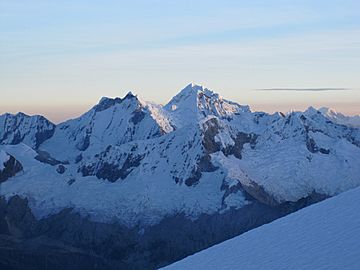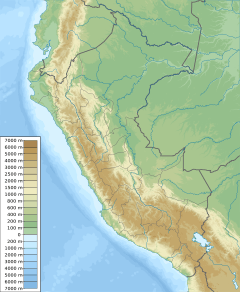Caraz (mountain) facts for kids
Quick facts for kids Caraz |
|
|---|---|
| Carás | |

Aguja III (on the left), Caraz I (center-left), Pukarahu (in the background, center, the highest peak) and Caraz II (in the background, center, exactly in front of Pukarahu, hiding most of it) as seen from the southeast
|
|
| Highest point | |
| Elevation | 6,025 m (19,767 ft) |
| Prominence | 2,772 m (9,094 ft) |
| Parent peak | Chacraraju |
| Geography | |
| Location | Peru, Ancash Region |
| Parent range | Andes, Cordillera Blanca, Peruvian Andes |
| Climbing | |
| First ascent | Carás I: 1-1955 via S.E. glacier, E. slopes: Variant N.E. ridge & snow slopes to top-1971: Rock face to Carás I/II col, N.E. ridge-1971: S. face-1979: S. face direct-1981: S.E. face-1981. Carás II: 1-1955 via S.E. ridge, descend S. ice face: N. face-1977: S.E. face to E. ridge-1986. Carás III: 1-1971 via N. side, S.W. ridge. |
Caraz, also known as Carás or Caraz de Santa Cruz, is a tall mountain in the Cordillera Blanca mountain range. This range is part of the larger Andes mountains in Peru. Caraz stands about 6,025 meters (19,767 feet) high.
You can find Caraz in the Ancash Region of Peru, specifically in the Huaylas Province. It is located in two districts: Caraz and Santa Cruz District. The mountain is inside Huascarán National Park, a protected area known for its beautiful peaks and glaciers. Caraz is southwest of Artesonraju and north of Lake Parón. Its lower slopes are near the cities of Santa Cruz and Caraz.
How High is Caraz?
Caraz is officially listed as 6,025 meters (19,767 feet) tall. However, it can be tricky to get an exact measurement for some peaks.
The mountain has a "topographic prominence" of 2,772 meters (9,094 feet). This means that Caraz rises 2,772 meters from the lowest point connecting it to a higher peak. Its "parent peak" is Chacraraju, which is a taller mountain nearby. Caraz is also about 6.6 kilometers (4.1 miles) away from any other peak of similar height.
First Climbers
The first people to successfully climb Caraz were Hermann Huber, Alfred Koch, and Helmut Schmidt. They reached the top in 1956.
See also
 In Spanish: Caraz (montaña) para niños
In Spanish: Caraz (montaña) para niños
- Hatunqucha
- Ichikqucha
- Sintiru


